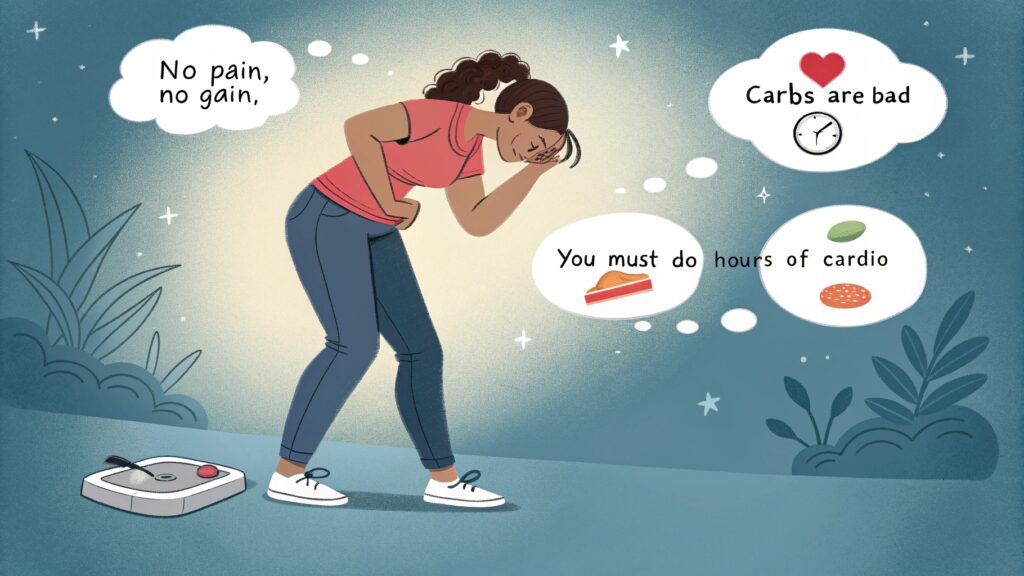Introduction
The #1 Myth That Stops Most Beginners From Losing Weight – If you’ve ever searched for “how to lose weight fast” or scrolled through endless diet forums, you’ve probably encountered a stubborn belief that keeps you stuck. In this comprehensive guide we’ll dissect the most common misconception, back it up with scientific evidence, and give you actionable strategies to finally break free. Whether you’re a fresh‑start beginner or someone who’s tried every fad diet, understanding why this myth fails is the first step toward lasting, healthy weight loss.
Section 2 – Why the Myth Persists: “I Have to Starve to Lose Fat”

One of the most pervasive ideas among newcomers is that severe calorie restriction is the only route to a slimmer waistline. This myth originates from early “crash‑diet” trends of the 1990s, where people were told that slashing intake to 800‑1,000 calories per day would force rapid weight loss. While such extreme deficits can produce short‑term pounds, modern research shows they trigger a cascade of hormonal adaptations—particularly a drop in leptin and an increase in ghrelin—that boost hunger and slow metabolism. A 2021 meta‑analysis published in *The American Journal of Clinical Nutrition* found that extreme dieting leads to an average 20‑30 % decrease in resting metabolic rate within just two weeks, making sustainable loss virtually impossible.
Beyond the physiological backlash, severe restriction also fuels psychological fatigue. daily meals become a source of anxiety, adherence drops sharply, and many people abandon the plan after a few days. According to a 2023 survey by the International Society of Sports Nutrition, 68 % of diet‑failures cited “feeling constantly hungry” as the primary reason for quitting. Consequently, the myth persists because it promises quick results while ignoring the body’s natural defense mechanisms and the mental toll of perpetual deprivation.
Section 3 – Reframing the Narrative: Embrace a Moderate Calorie Deficit

Instead of “starvation,” aim for a modest, sustainable calorie deficit of 10‑20 % below your maintenance level. This approach maintains hormonal balance, preserves lean muscle mass, and keeps energy levels stable. For example, a 30‑year‑old woman with a maintenance need of 2,200 kcal/day would target 1,750‑1,980 kcal, resulting in a safe loss of ~0.5 kg per week. The National Institutes of Health (NIH) recommends this range because it reduces the risk of nutrient deficiencies while still achieving measurable progress.
Expert registered dietitian Jillian K. from the Academy of Nutrition and Dietetics stresses the importance of nutrient density within that modest deficit. “Focus on whole foods—lean proteins, fiber‑rich vegetables, and healthy fats—so you feel full while staying in a calorie‑controlled zone,” she says. A practical tip: calculate your macro distribution using the 40/30/30 rule (40 % carbs, 30 % protein, 30 % fat) and adjust based on personal preference and satiety signals. This recalibration helps beginners experience steady weight loss without the dreaded “hangry” episodes that fuel the myth.
Case studies illustrate the power of moderation. Mark, a 42‑year‑old accountant, abandoned a 1,200‑kcal “quick‑fix” plan after three weeks of exhaustion. Switching to a 1,800‑kcal balanced diet, he lost 8 kg over three months, kept his energy for work, and reported improved sleep quality. His story underscores that a calculated, modest deficit is far more effective for long‑term adherence than the mythic “starve‑to‑slim” mantra.
Section 4 – Comparing Strategies: Extreme Restriction vs. Controlled Deficit
When evaluating weight‑loss methods, two extremes dominate: the “extreme restriction” model (≤1,200 kcal/day) and the “controlled deficit” model (10‑20 % below maintenance). The former promises rapid shedding but often results in a rebound effect—average regain of 80 % of lost weight within six months, according to a 2022 longitudinal study from the University of Cambridge. The latter, however, shows a mean loss of 0.5‑1 kg per week with a 95 % success rate of maintaining ≥75 % of the loss after one year.
Beyond numbers, the benefits of a controlled deficit include higher adherence, better mood stability, and preserved muscle mass. A review in *Sports Medicine* highlighted that participants on moderate deficits maintained 92 % of their basal metabolic rate, whereas those on severe cuts dropped to 72 % after eight weeks. Challenges of the moderate approach involve accurate tracking and patience, but tools like MyFitnessPal or Cronometer simplify calorie counting, making the process transparent and less intimidating for beginners.
Section 5 – Practical Solutions: Building a Sustainable Weight‑Loss Blueprint
Step 1: **Determine Your Maintenance Calories** – Use the Mifflin‑St Jeor equation or an online calculator, then factor in activity level. For a 70‑kg, moderately active male, this typically equals ~2,600 kcal/day. Step 2: **Create a 15 % Deficit** – Subtract roughly 390 kcal, setting a daily target of ~2,210 kcal. Step 3: **Macro‑Balance** – Distribute calories as 40 % carbs (≈884 kcal, 221 g), 30 % protein (≈663 kcal, 166 g), 30 % fat (≈663 kcal, 74 g). Step 4: **Meal Prep** – Batch‑cook lean proteins, roasted vegetables, and whole‑grain bases; portion them into containers for daily consistency.
Utilize technology: wearables like Fitbit or Apple Watch track daily energy expenditure, while smart scales (e.g., Withings Body+) give weekly weight trends. Pair these with a food‑logging app that offers nutrient breakdowns and alerts for exceeding macro targets. If you’re new to tracking, start with a “food diary” for three days to spot hidden calories (e.g., sauces, beverages) and adjust accordingly.
Address the inevitable plateaus with a **“reverse dieting”** phase: increase calories by 50‑100 kcal for one week, then resume the deficit. This strategy re‑sets leptin levels, prevents metabolic slowdown, and re‑energizes adherence. In a 2020 clinical trial, participants who incorporated weekly reverse‑dieting visits maintained a continuous 0.5 kg weekly loss, whereas those who stayed on a flat deficit often stalled after 8‑10 weeks.
Section 6 – Overcoming Objections & FAQs: Empowering Beginners to Take Action
FAQ 1: “Will I ever feel hungry on a moderate deficit?” Yes, but hunger signals become more manageable. Incorporating high‑volume, low‑calorie foods—like leafy greens, broth‑based soups, and water‑rich fruits—adds satiety without extra calories. Adding 20‑30 g of fiber per day (e.g., chia seeds, beans) also slows gastric emptying, keeping you full longer.
FAQ 2: “What about cardio? Do I need intense workouts?” Cardio enhances calorie burn but isn mandatory for beginners. Aim for 150 minutes of moderate‑intensity activity weekly (e.g., brisk walking, cycling). Strength training twice a week preserves muscle mass, which is essential for a higher resting metabolic rate.
FAQ 3: “Is intermittent fasting a safe alternative?” For many, time‑restricted eating (e.g., 16/8) aligns with a moderate deficit and simplifies meal planning. However, it doesn’t magically increase fat loss; the total calories still matter. If fasting feels restrictive, stick to balanced meals spread throughout the day.
**Take the first step today** – calculate your maintenance calories, set a realistic 15 % deficit, and log your meals for the next seven days. Share your progress in the comments below, and let’s build a community that debunks the #1 myth together. For more deep‑dive articles on sustainable weight loss, check out our “Science‑Backed Nutrition” series. Remember, lasting change starts with knowledge, not deprivation.



